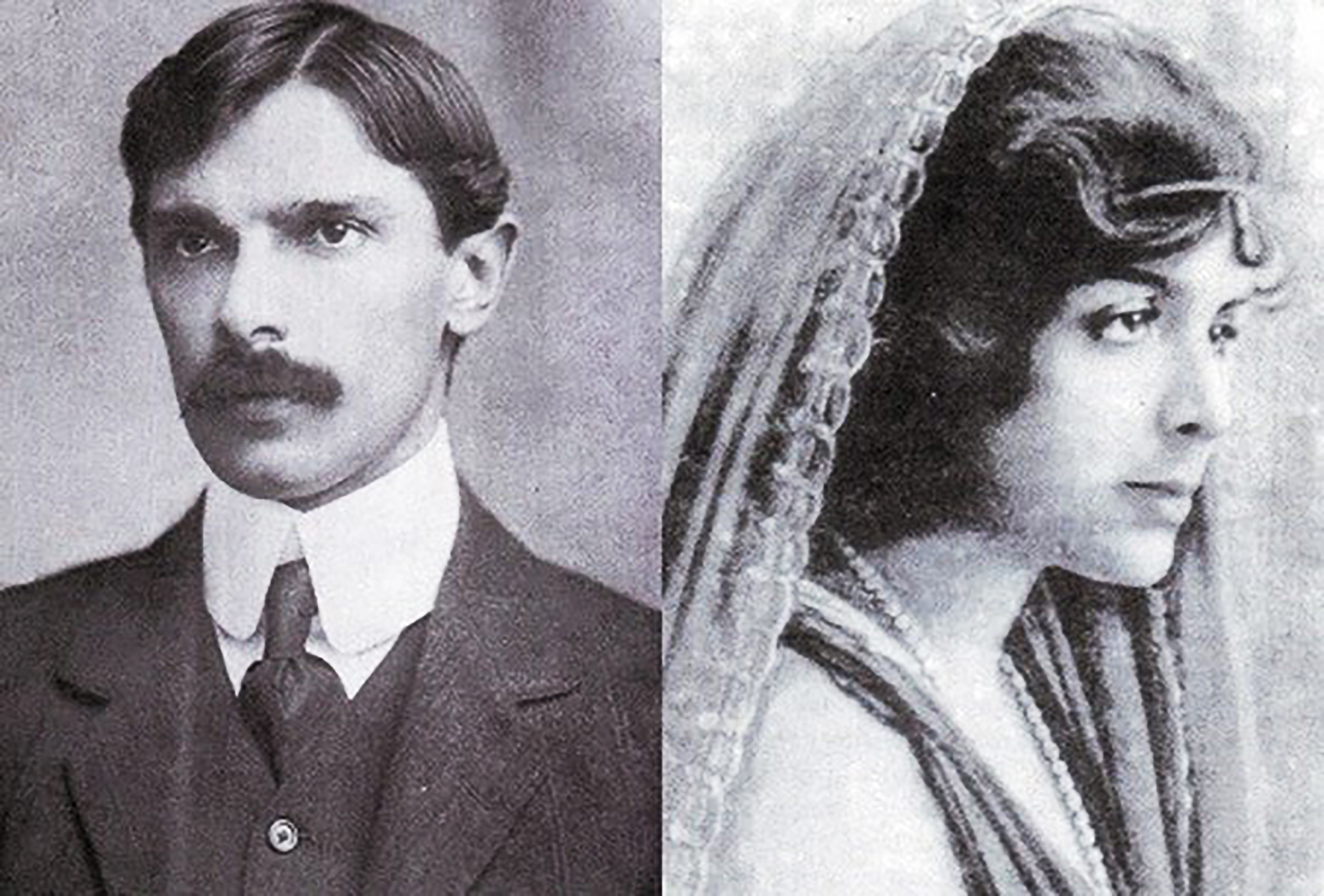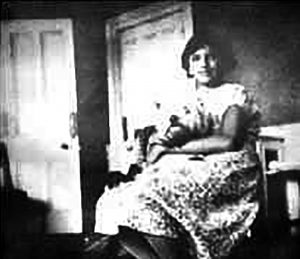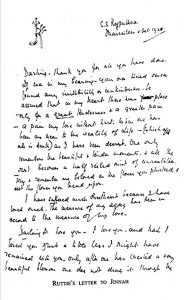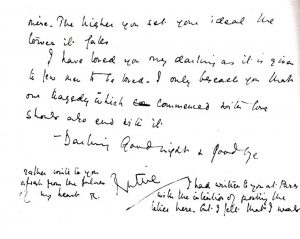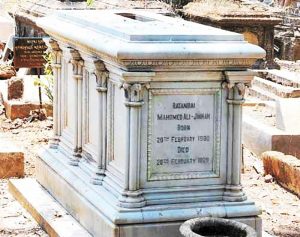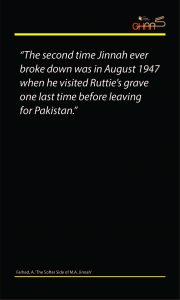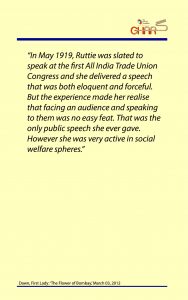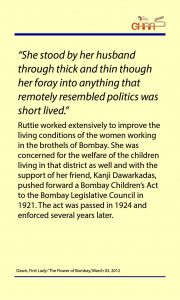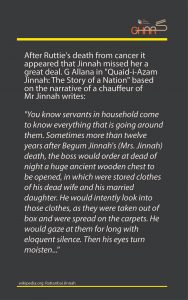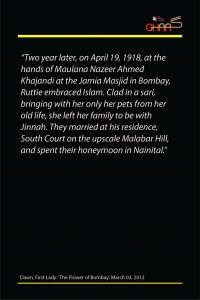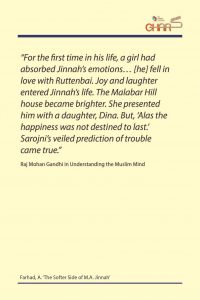Precociously bright, gifted in every form of art, beautiful in every way.. she seemed like a fairy princess.
The Married Life of Jinnah and Ruttie
Jinnah and Ruttie met at the Petit Chateau in Darjeeling; Rattanbai Petit, the 16-year-old daughter of the rich Parsi Baronet Sir Dinshaw Petit and Jinnah, a established lawyer and a politician. He was twice her age and a Muslim. They married in secret two years later, on April 19, 1918 after she converted to Islam.
“For the first time in his life, a girl had absorbed Jinnah’s emotions… [he] fell in love with Rattanbai. Joy and laughter entered Jinnah’s life. The Malabar Hill house became brighter. She presented him with a daughter, Dina. But, ‘Alas the happiness was not destined to last.’ Sarojni’s veiled prediction of trouble came true.”
Raj Mohan Gandhi in Understanding the Muslim Mind
Two years later, on April 19, 1918, at the hands of Maulana Nazeer Ahmed Khajandi at the Jamia Masjid in Bombay, Ruttie embraced Islam. Clad in a sari, bringing with her only her pets from her old life, she left her family to be with Jinnah. They married at his residence, South Court on the upscale Malabar Hill, and spent their honeymoon in Nainital.
March 03, 2012: Dawn, First Lady: The Flower of Bombay
By all accounts, Ruttie and Jinnah’s married life at that time was a fairytale. Everyone who knew the couple has commented on how much they loved each other. Jinnah gave up the membership of his club where he spent evening playing chess and billiards and would come straight home spending the whole evening in the garden talking to his wife. Otherwise not wasteful with money, Jinnah happily paid the vast sums Ruttie spent on decorating their residence or buying the expensive clothes she was fond of. There can be no doubt that Ruttie was the only woman for whom Jinnah ever felt romantic love.
Butt, A. The Nation: Jinnah and Ruttie: When love is not enough, 24 December, 2016
”Jinnah is worth it all – he loves her: the only really human and genuine emotion of his reserved and self-centered nature. And he will make her happy.”
Mrs. Naidu’s letter to Syed Mahmud
Their marriage began to crack after 1921. Ruttie moved to London with their daughter Dina in 1922. In June 1928, they had separated. Ruttie fell ill and died on February 20, 1929 on her 29th birthday.
Ruttie’s Last Letter to Jinnah
“Darling – thank you for all you have done. If ever in my bearing your once tuned senses found any irritability or unkindness – be assured that in my heart there was place only for a great tenderness and a greater pain – a pain my love without hurt. When one has been as near to the reality of life (which after all is Death) as I have been dearest, one only remembers the beautiful and tender moments and all the rest becomes a half-veiled mist of unrealities. Try and remember me beloved as the flower you plucked and not the flower you tread upon. I have suffered much sweetheart because I have loved much. The measure of my agony has been in accord to the measure of my love. Darling I love you – I love you – and had I loved you just a little less I might have remained with you – only after one has created a very beautiful blossom one does not drag it through the mire. The higher you set your ideal the lower it falls.
I have loved you my darling as it is given to few men to be loved. I only beseech you that the tragedy which commenced in love should also end with it.
Darling Goodnight and Goodbye.
Ruttie.
I had written to you at Paris with the intention of posting the letter here – but I felt that I would rather write you afresh from the fullness of my heart. R.”
Ruttie’s Untimely Demise
When Ruttie’s body was lowered into the grave he was asked to be the first to throw earth into the grave. He did that and as he straightened up, he started to cry not just silent tears but with hands over his face he sobbed like a child for many minutes. He did not seek anyone’s hand or anyone’s shoulder; but in tune with his personality he cried alone. And having finished he wiped his tears and with his face returning to stone walked back to his car.
Butt, A. The Nation: Jinnah and Ruttie: When love is not enough, 24 December, 2016
After Ruttie’s death from cancer it appeared that Jinnah missed them a great deal. G. in “Quaid-i-Azam Jinnah: The Story of a Nation,” based on the narrative of a chauffeur of Mr. Jinnah writes:
“You know servants in household come to know everything that is going around them. Sometimes more than twelve years after Begum Jinnah’s (Mrs. Jinnah) death, the boss would order at dead of night a huge ancient wooden chest to be opened, in which were stored clothes of his dead wife and his married daughter. He would intently look into those clothes, as they were taken out of box and were spread on the carpets. He would gaze at them for long with eloquent silence. Then his eyes turn moisten…”
Wikipidia.org: Rattanbai Jinnah
The second time Jinnah ever broke down was in August 1947 when he visited Ruttie’s grave one last time before leaving for Pakistan.

